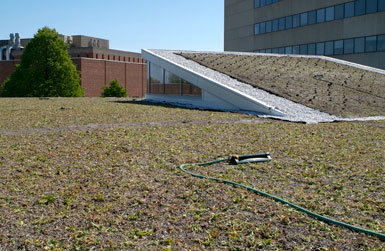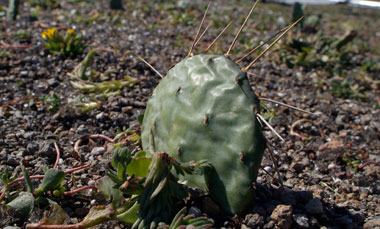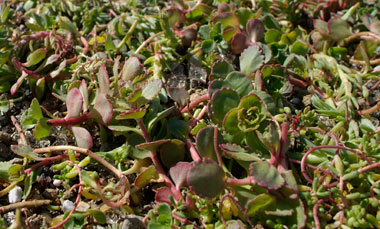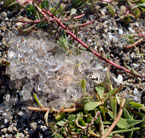Inside Iowa State
Inside ArchivesSubmit newsSend news for Inside to inside@iastate.edu, or call (515) 294-7065. See publication dates, deadlines. About InsideInside Iowa State, a newspaper for faculty and staff, is published by the Office of University Relations. |
May 21, 2009 
Four layers of materials, topped by vegetation, make up the new "green" roof on the College of Design's King Pavilion. Photo by IT Services. University's first green roof installed on Design additionby Anne Krapfl Summer, it seems, is here. The flip-flops are out . . . campus offices are open early . . . sprinklers are watering the vegetation on the roof of the Design addition . . . Hey, what was that last one? Work should wrap up by early June on the Design Center's north addition -- known as the King Pavilion -- and one of the last tasks was to install a green roof, an open-face sandwich of sorts that will support hardy plants. The roof is one component in the building project, for which the College of Design hopes to receive a gold rating in the Leadership in Energy and Environmental Design (LEED) program from the U.S. Green Building Council. Other features of the building include windows that provide natural light and natural ventilation (thus no AC, just dehumidifiers), wall insulation made from recycled denim and recycling of more than 90 percent of construction waste. "We have wanted to try a roof like this, and this seemed to be the place to do it," said project manager Kerry Dixon-Fox, an architect in facilities planning and management. "This building provides a great opportunity for our architecture students. It also shows landscape architect students that they're not restricted to the ground." Why this roof?The benefits to the environment of a green roof include:
The roofLast week, crews planted about 20 varieties of plants atop four layers and about four inches of special materials. Next to the usual roof membrane is a thick black fabric that helps protect the membrane and extend its life. On top of the fabric is a composite drainage mat (made with 40 percent post-industrial recycled content) of loosely entangled fibers. In this layer, excess water moves out to the corner roof drains. On top of this is a moisture retention mat, made of recycled synthetic fiber, which holds some water. And on top of this is about three inches of growing medium made of gravel and sand. Dirt, especially wet dirt, would be too heavy, Dixon-Fox noted. For now, as the young cuttings take root and get established, the roof also is sprinkled liberally with polymer gel crystals. These absorb -- and release -- water in hundreds of times their weight. Dixon-Fox said a landscape architecture firm, Conservation Design Forum, Chicago, designed the roof for the Iowa climate. The plantings include:
The green roof design also features three feet of white rock bordering the roof's edges. Dixon-Fox said winds coming up and over the edge of the roof wouldn't allow vegetation to get established in this zone, so it wasn't even planted. The King Pavilion roof includes a one-year warranty. Key to its success will be the cuttings establishing roots this summer. Another key was getting the planting done this month. Dixon-Fox said green roofs planted in April and May enjoy about a 90 percent success rate. 
Hardy prickly pear is one of the plant selections on the sloped section of the King Pavilion roof. 
Fourteen varieties of sedum comprise much of the roof
vegetation. |

They resemble small ice cubes, but these soft gel crystals absorb and release water. They'll help plants in the roof garden get established this summer. Photo by IT Services. Quote"This building provides a great opportunity for our architecture students. It also shows landscape architect students that they're not restricted to the ground." Kerry Dixon-Fox |